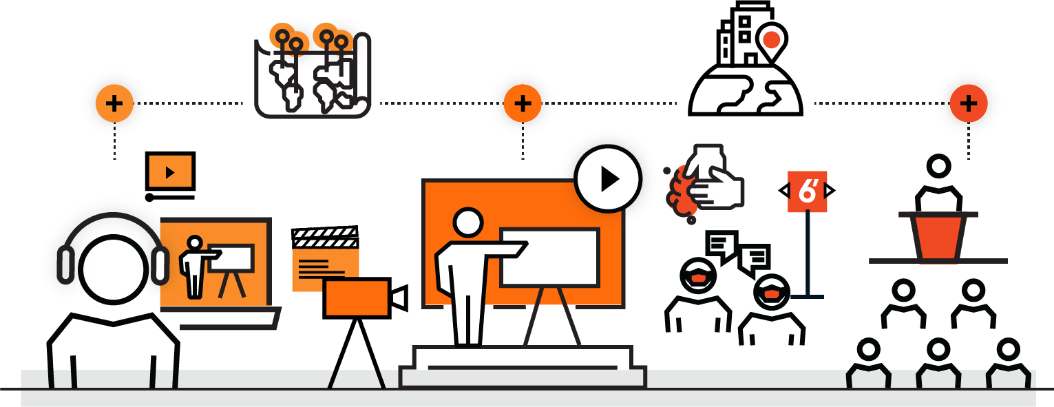
Early in the year, many event professionals were faced with a challenge many have never faced before, frantically shifting their event strategies to adapt to a less familiar medium; the virtual space. With that came reactive responses due to time constraints, navigating the unknown and the lag in virtual evolution over the past 12 years. As the proverbial dust is settling and we have a moment to breathe, it’s time to shift to proactive solutions that have longevity, prepare for what’s to come and implement what we’ve learned.
We’re not the only ones who’ve had time to settle in. Attendees are becoming more acclimated to the virtual world, becoming more sophisticated and subsequently more impatient with what they’re experiencing. We’re all eager to return to normal, but regardless of what happens over the coming months, normal will not be the same as before. Live, in-person experiences, once our Plan A with the virtual extension coming in as our trusted Plan B, has now swapped places. And while that complete swap to virtual may be temporary, the inclusion of virtual will forever flip from a temporary band-aid or light extension of an experience to a more permanent, robust element in every smart event strategy.
The future is still unclear but there’s one thing we do know: the event of the future will forever be impacted. It’s time to recognize that shift now and prepare for what’s to come.

With the urgent shift, assumptions that the selection of a platform used for hosting an experience is more than a key consideration but instead the holy grail of a successful virtual event has become the subconscious mindset of many. It makes complete sense–if attendees are going to be spending all of their time within a virtual platform instead of a live physical venue, it should take priority in the process, right? By focusing so much on the platform alone or worse, making it the first step within your process, the goals and objectives of why you’re providing an experience in the first place get neglected and subsequently, the elements that make it a success: impactful content, immersive storytelling and a comprehensive attendee journey.
Prior to shifting to a proactive virtual strategy, audit your process honestly. Are you allowing the platform to dictate your strategy? Are you placing priority on which platform is chosen over the other elements that define a successful event strategy? Are you letting the platform drive your decision making? If you’ve answered yes to any of these questions, it’s time to flip your process:
Define your goals
and objectives
Design the experience
and attendee journey
Select the medium that
will best accommodate
Now that you’ve gut checked your process, start planning for what’s next.
It goes without saying by now, virtual will never be pushed to the back burner again. Virtual components unlock more than expanded reach but also the vast amount of audience insight you can gain. Collecting as much data and measurements as possible only helps inform your future strategies – including when live in-person. Virtual has given us a much different understanding of how our audience is engaging with various elements. At the forefront of any campaign or event initiative, develop a comprehensive measurement plan that’s informed by your goals and objectives.
Ensure you’re tracking every touchpoint over the campaign period (another reason why you need a platform), using KPIs that make sense, assessing over time and analyzing what these collective inputs mean to better uncover insights that inform and inspire future strategies.
Some key measurement points to consider in your plan are:
Reach
Overall satisfaction
Platform engagement
Dwell time
Playbacks
Play time
Retention
Clicks
Take a moment to pause and revisit your event strategy’s original goals and objectives to level-set. With needs and challenges of businesses and audiences shifting alike, your goals and objectives may need some adjustment as well. From there, get reacquainted with these and go through a very thoughtful, strategic review of not only what these mean but assessing how your approach the past few months may, or may not, have contributed.
As you reassess, a few questions to consider are:

Not only will our event strategies forever be changed, but the needs of our attendees are fundamentally changing as well, both from a cognitive standpoint but also in expectations. The virtual world has allowed us to collect more data than ever before on our audience’s interests, learning behaviors, needs and preferences–providing us with a deeper look into the mindset of our attendees and informing what will need to be considered in the future. Not only that, but this period in everyone’s lives has caused seismic shifts in behavior.
Revisit your target audiences to examine how their personas and priorities have changed. Humans have always craved human connection, which is why live events have been a proven tactic within marketing that guarantees strong ROI. With isolation on the rise, our audience’s existing sentiments around inclusion, purpose, value and contribution are at an even higher priority.
Some predictions are:

Humans are becoming more, well, human.
Virtual events have a tendency to feel very transactional and with empathy, unity and appreciation all on the rise, the need to inject more humanity into an event will be imperative.


Sustainability and purpose-driven initiatives will take precedence.
With virtual bringing an even larger positive impact on our planet and the unmistakable shift in social responsibility, the priority of both is here to stay.
Time has become a luxury.
Many have had the chance to slow down, uncovering what’s most valuable to them, what’s worth consumption and how to best spend their time. If you’re going to ask for someone’s time, it better be worth it.


The necessity for control over one’s journey.
Attendees have become more inclined and familiar with operating their own event journey, making it more suitable and convenient for them.
Renewed interest for the nostalgic.
Time at home spent engulfed in technology has forced us to revert back to old ways of disconnecting. Incorporating more analog, tech-free experiences will be necessary to feed this interest.


Content consumption has changed vastly.
Highly-produced segments, shorter, more bite-sized. We’ve heard it all and it’s here to stay. Treat your content like a prolonged campaign, making it digestible and therefore more retainable.
Virtual events are not video meetings on steroids.
Captivating an audience virtually does not mean using a do-it-yourself production model after the invite. Like a live event, flawless production and content strategy matter and are key drivers in creating a compelling virtual experience.
Your event strategy is not about one moment in time but how you engage over an extended period of time through various channels. The rise of virtual has taught brands that connecting with a target audience should be seen as many connected events and experiences in various shapes and sizes versus one and done. A pre- and post-event communications plan should be approached like a content marketing plan: outlining the why, when and where to engage and, as a result, defining which experiences work best at each step.

Assess all the content and messaging that would have typically been incorporated into your multi-day event by asking yourself:
TL;DR It’s no longer a sprint, it’s a marathon.
Or in short, get comfortable with being uncomfortable. We’ve all had to acclimate to new ways of living in our personal lives, and let’s accept it–event professionals have had to adopt new roles and responsibilities as well. Whether we like it or not, we’re all fulfilling some form of a communicator role now. Effective communication, both internal and external, is the most important factor driving our goals. And the need is not going anywhere any time soon.
More importantly, the creator mentality is a necessity, leaning into out-of-the-box thinking and tapping into strategic mindsets that push boundaries to help you and your brands stay one step ahead.

Prioritize training and development of your internal team that helps arm them with the right knowledge and resources to understand communications, digital marketing and strategy. Even further, audit your current industry partners to ensure you’re equipped with an external team that not only specializes in live event production, but brings communication experts, creative strategists and digital gurus to the table.
Being smart in this new world doesn’t mean always having all the answers yourself but, instead, that you’ve assembled the right team of experts who, collectively, do.
At the onset, the initial reaction to the new event world was choosing turnkey solutions, and rightfully so. We were all in a mindset of impermanence, hopeful that there was an end in sight. There is still an end in sight, but the end will still incorporate virtual. Now that you have time to reassess your strategy and your process, rethink how you tap into platforms to carry out your experiences.
The concept of virtual is not new, but it’s never had to be our plan A. Many of the well-known virtual platforms that serve as those turn-key solutions were not designed to be plan A, lacking the sophistication and support of our evolved needs. Move from reactive tools to sophisticated digital solutions by exploring the more bespoke, custom opportunities that fit your precise needs. A couple considerations while identifying tools for longevity:

Avoid making it look like virtual is a substitute for live events.
Because it’s not. More importantly, remove the construct that physical navigation is required by reinventing exploration that’s functional in the space it’s living in. For example, instead of diverting to a platform that mimics a convention center, tap into interesting ways for attendees to navigate in the way it’s actually being delivered to them; virtually. Whether this be through immersive UX design, cinematic interstitials or other digital incorporations. Modern web experiences should take cues from modern website UX. That’s the venue and it has its own set of best practices, rules and user expectations.
Focus on data centralization.
Adding a virtual platform is adding another channel. Choose one that can connect to or funnel in your other data sources. With hundreds to tens of thousands of attendees, you’re collecting an abundance of data points from registrant information to analytics. Avoid data overload and make sure your channels are connected to ensure you’re capturing the right data, at the right time, all in one place.
In the end, most of us will agree (unbiased or not) that virtual will never be a substitute for live. The idea of preparing to return to live may feel premature, but it is imminent. So why not begin prepping for it now? Hybrid events have been the central theme of what the event of the future may look like, but there’s a myriad of elements that need to be thoughtfully addressed and assessed to prepare for that point in the future.
Interested in working with us?
Ready to light a fire?
Let’s strike up a conversation.
